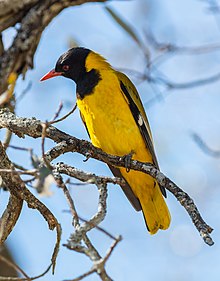

| Black-headed oriole | |
|---|---|

| |
| Scientific classification | |
| Domain: | Eukaryota |
| Kingdom: | Animalia |
| Phylum: | Chordata |
| Class: | Aves |
| Order: | Passeriformes |
| Family: | Oriolidae |
| Genus: | Oriolus |
| Species: |
O. larvatus
|
| Binomial name | |
| Oriolus larvatus Lichtenstein, MHC, 1823 | |
The black-headed oriole (Oriolus larvatus) is a species of bird in the family Oriolidae. It is found in Africa and has a very striking appearance with a bright yellow body, contrasting black head and flesh-coloured beak.
Some authorities have considered the mountain oriole to be a subspecies of the black-headed oriole. Alternate names for the black-headed oriole include the African black-headed oriole, Eastern black-headed oriole and Eastern oriole.
Five subspecies are recognized:[2]
The black-headed oriole has a bright yellow body, contrasting black head and flesh-coloured beak. The voice is a liquid-sounding warble, accompanied by imitations and whistles.
It breeds in much of sub-Saharan Africa from South Sudan and Ethiopia in the north to South Africa in the south.
It inhabits dry tropical forests, especially acacia and broad-leaved woodlands, and dense shrubland areas, where it is more often heard than seen despite the brightness of its plumage.
The black-headed oriole forages in the canopy, feeding on small fruit as well as large insects. The young are fed mostly with caterpillars.
| Oriolus larvatus |
|
|---|---|